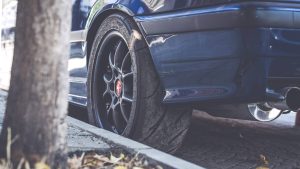No matter what kind of vehicle you drive, proper tyre tread depth is crucial for road safety, and it tends to be overlooked. When we talk about car safety, the first things that most drivers think of include seatbelts, airbags and advanced assistance systems.
Tyre tread depth can make a huge difference in road safety, especially in rainy and wet conditions. It affects the grip and how your tyres disperse water and respond in emergencies. However, many drivers will not check it very often.
What is Tyre Tread Depth?
Simply explained, tread is the rubber on your tyre that has direct contact with the road. Tread depth is the vertical measurement between the top of the tread rubber and the bottom of the tyre’s deepest grooves. Basically, tread depth represents the amount of usable tread you have on your tyre.
New car tyres have an average tread depth between 8 and 9 millimetres. As you drive your car, the tread wears down, which further affects grip, braking distance and vehicle control. The legal minimum of tyre tread depth varies in many countries.
For example, in the UK and the majority of Europe, the legal minimum tread depth is 1.6mm across the central three-quarters of the tyre. However, experts suggest you should replace your tyres even sooner, usually when tread depth reaches 3mm for summer tyres and 4mm for winter tyres, in order to maintain overall safety and braking performance.
How to Measure It?
As stated earlier, it is important to keep the tyre tread depth in mind and occasionally check it, especially if you’re driving on tyres that you have bought a long time ago.
Firstly, you should check out the tread wear indicators that are built in to grooves of your tyres. They are the small horizontal bars that are evenly spaced around the tyre’s circumference. Once your tyre has worn level with these bars, it means that you have reached the minimum depth and need a replacement. So, these indicators will tell you that you’ve reached 1.6mm. At this point, driving in wet conditions can be significantly affected.
The best tool you can use to check tyre depth is a tyre gauge. It comes in various forms, such as cards that have colour indicators or digital depth gauges. You can place them into the tyre’s groove and see how close you are to reaching the minimum depth.
Ensure to check the tread depth in various locations. That way, you can see if the tread is uneven, which indicates a misaligned wheel. If you spot these issues, you can visit Tayaria, the established car tyre shop that offers great services and products at some of the best prices in Malaysia.
Some of the tyre brands also have numbers as tread depth indicators (4, 6 or 8mm). For example, the number 8 becomes unreadable once the tread wears to a depth of less than 8mm.
Replacing Your Tyres: When and Why
Testing carried out by Continental showed that the braking distance from 80 km/h to a standstill with 8mm of tread was 42.3 metres. With a 3mm tread, the braking distance increased to 51.8m and with 1.6mm it increased to 60.9m.
Even though the legal minimum in many countries is 1.6mm, the above-mentioned tests show how important it is to change your tyres even before the tread reaches the minimum. In wet conditions, braking distances and the traction you have are further affected by the rain, meaning that it is one of the most alarming issues of low tread depth. When the traction is affected, handling your vehicle can be very difficult and make your vehicle more susceptible to punctures.
Regular checks can help you prevent this. Another thing to keep in mind is reducing your speed in wet conditions if you know your tread depth has worn down. This can help you shorten your braking distance in case of an emergency and have better traction until you visit your car tyre shop.
Be Prepared
Replacing your tyres can be expensive; however, checking your tyre pressure regularly can help you prevent that. Underinflated tyres tend to wear faster, while overinflated one can affect grip.
Regular tyre alignment and balancing prevent uneven tread wear and further improve handling. And the final thing is your driving habits: avoid harsh accelerations or heavy braking if it’s not necessary, as it shortens tyre life.
Although tyre tread depth is overlooked by most of us, it has a huge impact on driving safety and car performance. Knowing how to measure it and when to replace your tyres can help you prevent accidents and other costly repairs. If you need new tyres, check your local Tayaria outlet.





